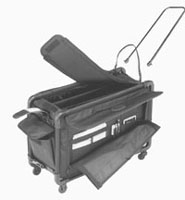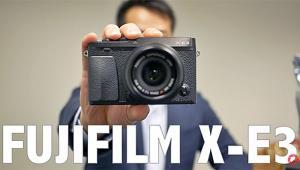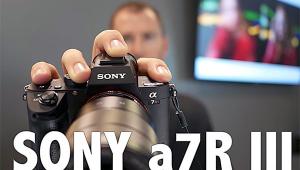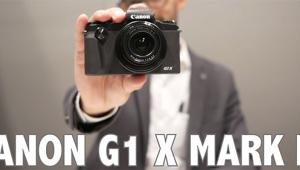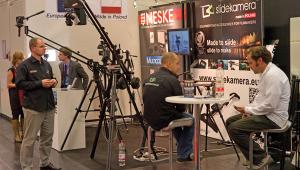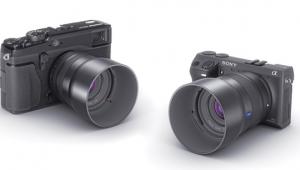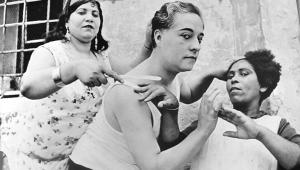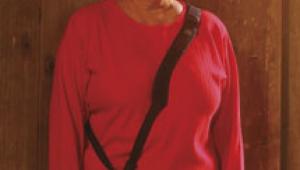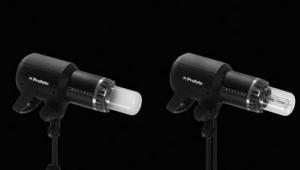PMA International
Studio Equipment, Bags, And The Unusual
As regular readers of Shutterbug
well know, my main area of interest is large format--which is not, unfortunately,
particularly well represented at PMA. My brief was, therefore, also
to cover studio equipment; accessories, bags, tripods, and the unusual. |
|||
Although I shall most certainly
be using it with camera bags, I reckon it will be still more useful for
securing things to my motorcycle, and I may well use it for securing valuables
in hotel rooms; there may also be other applications which I have yet
to think of. At around $65, it is not cheap, but it could save its price
many times over. |
|||
In general, I would rather
pay extra for an American-made or British-made bag, because you are usually
paying for superior materials as well as for more expensive labor, but
in all fairness, some manufacturers from the Far East do use first-class
materials, so the savings come only from lower labor costs and (in some
cases) for lower costs for top-flight materials. A particular favorite
is the leather bags from World Richman Corporation, which are very well
made from the best possible materials, but still sell at very reasonable
prices. They have revised their line-up for 1999, and you can feel the
superior quality of the new leather--which given the excellent quality
of the older bags is very impressive indeed. |
|||
Vanguard's range is (as
ever) bewilderingly huge, and spans the range from basic to high-end,
but the black nylon Athena line-up deserves particular mention for its
looks; a common reaction, apparently, has been, "At last someone
recognizes that women take pictures too, and need camera bags."
Other new ranges include the modestly-priced Polo and Victory series in
polyester as well as a high-end Marco series made of their extraordinarily
leather-like synthetic "kote skin"--so you can have Marco
Polo. The Professional series are (as the name implies) aimed at the pro,
and are again made of kote skin. The new Cortina series is padded Cordura,
positioned as an upgrade from Polo, while the Columbus series is in attractive
blue nylon. |
|||
Tenba showed a revised carrying
system for their superb airline-size backpack, allowing even more comfort
and incorporating a cover which neatly conceals all loose straps; this
can apparently be retrofitted to existing backpacks, which is good news
for me, as this has become my standard carryon luggage. They also had
the improbable "kilt," which looks pretty much like its name
suggests: a skirt of large pockets, supported over the shoulders by two
straps. I'm not sure I'd use it outside the studio, but in
the studio, it should be very useful. They also had an excellent new daypack;
I begged one for review, and wore it throughout the show, so I can vouch
that it is comfortable, even when laden with ridiculous quantities of
brochures as well as a camera. Other introductions are the small "Walkabout"
cases and a new, wheeled case designed especially for wedding photographers. |
|||
Another bag I particularly
liked was one with a built-in changing bag, from Kiev USA: the only bag
(as far as I know) that Saul Kaminsky sells, but a very useful device,
especially for the large format user. |
|||
Another departure from the
strict definition of a bag is the Dry Box from Hakuba, a shatterproof
plastic box with a space for desiccant cartridges. For carrying film,
in particular, on hazardous journeys, these could be very useful. The
largest of the three sizes features wheels on the bottom. |
|||
Hakuba's ballistic nylon
Neo series will no doubt contribute to an ever-wider awareness of this
manufacturer's high-quality products. Beseler has two new little
bags in their highly successful Contour series. Phoenix showed four new
bags, two of nylon for tiny 24mm cameras such as the Canon Elph, Konica
Revio, or Fuji Tiara, and two polyester backpacks. Samsonite showed some
very useful looking, and astonishingly modestly-priced, portfolio cases.
|
|||
When you look at the vast majority
of lightweight tripods, the reaction is, "Well, it's really
nice and light and compact, but it's a pity they didn't spend
a few bucks extra and make it properly." With the Snapman, they
did go the extra distance, and the result is superb. I have already used
it with 5 lb Alpa cameras, and although you have to tighten the ball pretty
fiercely, it worked perfectly. This is going to become one of my most
used tripods. |
|||
KB Systems had a new, big wooden
tripod in ash at a very reasonable price, and if you are in the market
for something which will hold your 8x10" Gandolfi a long way above
the ground, this could be the answer. For further information, visit the authors website at: www.rogerandfrances.com. |
- Log in or register to post comments

